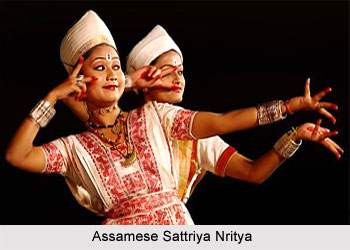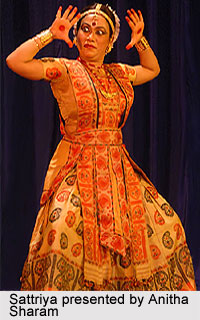 Sattriya or Sattriya Nritya, as it is also known as, happens to be one among eight main Indian classical dance traditions. Sattriya, since its creation in 15th century Assam by Vaishnav saint Srimanta Sankardeva, has remained a living tradition. The creation of Sattriya Nritya by Sankardeva was an accompaniment to the Ankiya Naat (a form of Assamese one-act plays devised by him), which were usually performed in the sattras, as Assam`s monasteries are called. With time as the convention grew and developed with the sattras, the dance form came to be called Sattriya Nritya.
Sattriya or Sattriya Nritya, as it is also known as, happens to be one among eight main Indian classical dance traditions. Sattriya, since its creation in 15th century Assam by Vaishnav saint Srimanta Sankardeva, has remained a living tradition. The creation of Sattriya Nritya by Sankardeva was an accompaniment to the Ankiya Naat (a form of Assamese one-act plays devised by him), which were usually performed in the sattras, as Assam`s monasteries are called. With time as the convention grew and developed with the sattras, the dance form came to be called Sattriya Nritya.
History of Sattriya
Sattriya Nritya emerged from the sanctum in the second half of 19th century. This form of dance originated in monasteries and then moved to the metropolitan stage. There were tough austerities and discipline that were maintained by the Sattras within their limitations, until the first half of 19th century. This dance is performed with highly dedicated and ritualistic manner by male dancers alone. There are lot of factors that can be contributed to the delayed acceptance and recognition of Sattriya Nritya. One of the main advantages of adhering to the principles of the sattras has been its ability to maintain its pure form, and distinct style. As Sattriya has made its journey to the demotic spaces of the world`s stages from the sanctified interiors of Assam`s sattras, it is time for an improvement of Sattriya Nritya`s aesthetic and artistic qualities. This dance form received huge fame and name after Sangeet Natak Akademi recognized Sattriya as one of the classical dance forms of India.
 Style and Technique of Sattriya
Style and Technique of Sattriya
The main theme of Sattriya has had mythological connotation. This is an artistic and meticulous way of presenting teachings to the people in an immediate, accessible and enjoyable manner. Conventionally, this dance form was performed only by male monks (also known as Bhokots) in monasteries as part of their daily rituals or to mark special festivals. In the modern days, Sattriya is performed on stage by women and men, who are not members of sattras, on themes not merely mythological.
Sattriya Nritya is divided into many genres: Apsara Nritya, Behar Nritya, Chali Nritya, Dasavatara Nritya, Manchok Nritya, Natua Nritya, Rasa Nritya, Rajaghariya Chali Nritya, Gosai Prabesh, Bar Prabesh, Gopi Prabesh, Jhumura, Nadu Bhangi, and Sutradhara. Among others, Sattriya Nritya, just like seven other schools of Indian classical dance, incorporates the doctrine required for a classical dance form: the treatises of dance and dramaturgy, like Natya Shastra, Abhinaya Darpana, and Sangita Ratnakara; a distinctive repertoire (marg) and the aspects of nritta (pure dance), nritya (expressive dance), and natya (abhinaya).
Sattriya Nritya is a genre of dance drama that tells mythical and religious stories through hand and face expressions. The basic dance unit and exercise of a Sattriya is called a Mati Akhara, equal to 64 just like in Natya Shastra, are the foundational sets that dancers learn during their training. The Akharas are subdivided into Ora, Saata, Jhalak, Sitika, Pak, Jap, Lon and Khar. A performance integrates two styles, one masculine (Paurashik Bhangi, energetic and with jumps), and feminine (Stri Bhangi, Lasya or delicate).
The hand gestures (mudras), footwork (padas), postures, rhythms, training of artists and other aspects of the Sattriya dance drama closely follow those described in Natya Shastra and other classical Hindu dance texts, and are quite similar to other major classical dances such as Odissi, Kathakali, Bharatanatyam and others found in south and north India. Some basic elements and features of Sattriya match those found in the Manipuri dance in neighboring Manipur state.
Music of Sattriya Nritya
Sattriya Nritya is performed with musical composition called borgeets (composed by Sankardeva among others) which are usually based on classical ragas. For tradition performance, the instruments that are used are khole (drums), taals (cymbals) and the flute. Some of the recent additions are the violin and the harmonium.
Costume of Sattriya Nritya
The costume of Sattriya dance is primarily of two types: the male costume comprising the dhoti and chadar and the paguri and the female costume comprising the ghuri, chadar and kanchi. Traditionally the costumes were of white or raw silk with use of red, blue and yellow for specific dance numbers. In earlier times velvet and satin materials were mostly used for the costumes. With change of time, as this dance form evolved from the sattras onto stage, the design and materials of the dance costumes changed.
Pat (also spelled paat) – a silk produced in Assam which is derived from the mulberry plant and muga silk (golden silk of Assam) is also used in preparing the dance costume. Other brilliant colours are also used in the female costumes. These hand-woven materials normally have intricate local motifs like Kingkhap, Miri Motif, Kolka etc. Uses of play-specific costumes are also seen in Sattriya dance. The dress of Krishna Nritya and Nadubhangi Nritya is of yellow and blue keeping in line with the attire of Lord Krishna. The Sutradhar Nritya also has its specific white costume with a special turban. Traditional Assamese jewellery is used in Sattriya dance. The jewelleries are made in a unique technique in Kesa Sun (raw gold). Artists wear Kopali on the forehead, Muthi Kharu and Gam Kharu (bracelets), different type of neck pieces like Mata Moni (for male dancers), Golpata, Dhulbiri (shaped like the musical instrument dhol), Bena (pendant shaped like a crescent), Jethipata (lizard shaped), Dugdugi (leaf shaped), Senpata (eagle shaped), Dhansira (strand of rice grain), Lokaparo (pigeon design), etc.
Sattriya Nritya at International Platform
Over the years, Sattriya Nritya has received greater acceptance and patronage both outside the state of Assam, and outside India. One of the Sattriya Nritya dancers promoting the dance art overseas is Madam Kavitha Supramaniam from Malaysia. Madam Kavitha Supramanaim is an accomplish dancer; learning the art under close guidance of her esteem teacher Preeti Chowdhury of Assam. In United States of America dancers such as Madhusmita Bora and Prerona Bhuyan, founders of Sattriya Dance Company, who follow the Uttar Kamalabari tradition, have been promoting this ancient dance form by performing at iconic dance festivals and organizing lecture demonstration events in various prestigious institutions around the world.
Sattriya has been patronized by grants from various institutions in USA such as Pew and Leeway foundation. Sattriya dance company made history in April 2018 by showcasing Sattriya Nritya for the first time ever at the Library of the Congress, USA. They have also taken this ancient art form to Nehru Center, London and have showcased the ancient Assamese tapestry Brindabani Vastra a part of which is housed at the Philadelphia Museum of Art, accompanied by dancer musician monks from Majuli. Sattriya has reached a greater audience and acceptance among the art connoisseurs of America due to the untiring efforts of the Sattriya Dance Company.
Eminent Artists and Sangeet Natak Academy Awardees:
Maniram Datta Moktar 1963
Bapuram Bayan Attai 1978
Roseshwar Saikia Bayan Moktar 1980
Indira P. P. Bora 1996
Pradip Chaliha 1998
Parmanand Borbayan 1999-2000
Ghana Kanta Bora 2001
Jatin Goswami 2004
Ganakanta Dutta Borbayan 2007
Manik Borbayan 2010
Sattriya Nritya, with time and exposure has found a lot more acceptance among the people of Assam. Apart from Assam, this dance has also faced tremendous appreciation outside the Indian mainland. There are dance gurus and dedicated performers who have helped to make this dance form a global affair. Added to that, the Government of Assam has also taken some steps to popularize this dance form in India, through its setting up of Sattriya Nritya School at Srimanta Sankardeva Bhawan, New Delhi.




